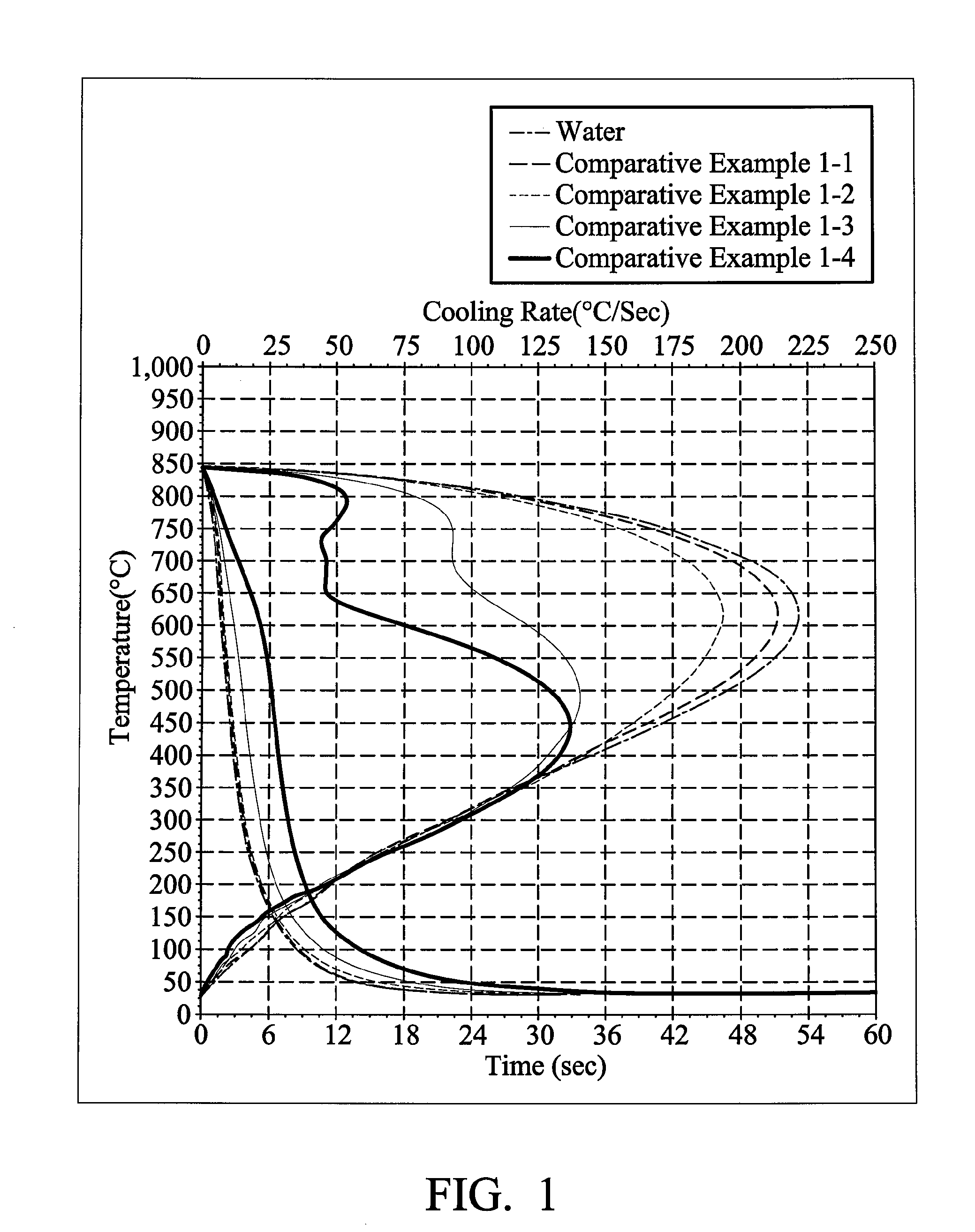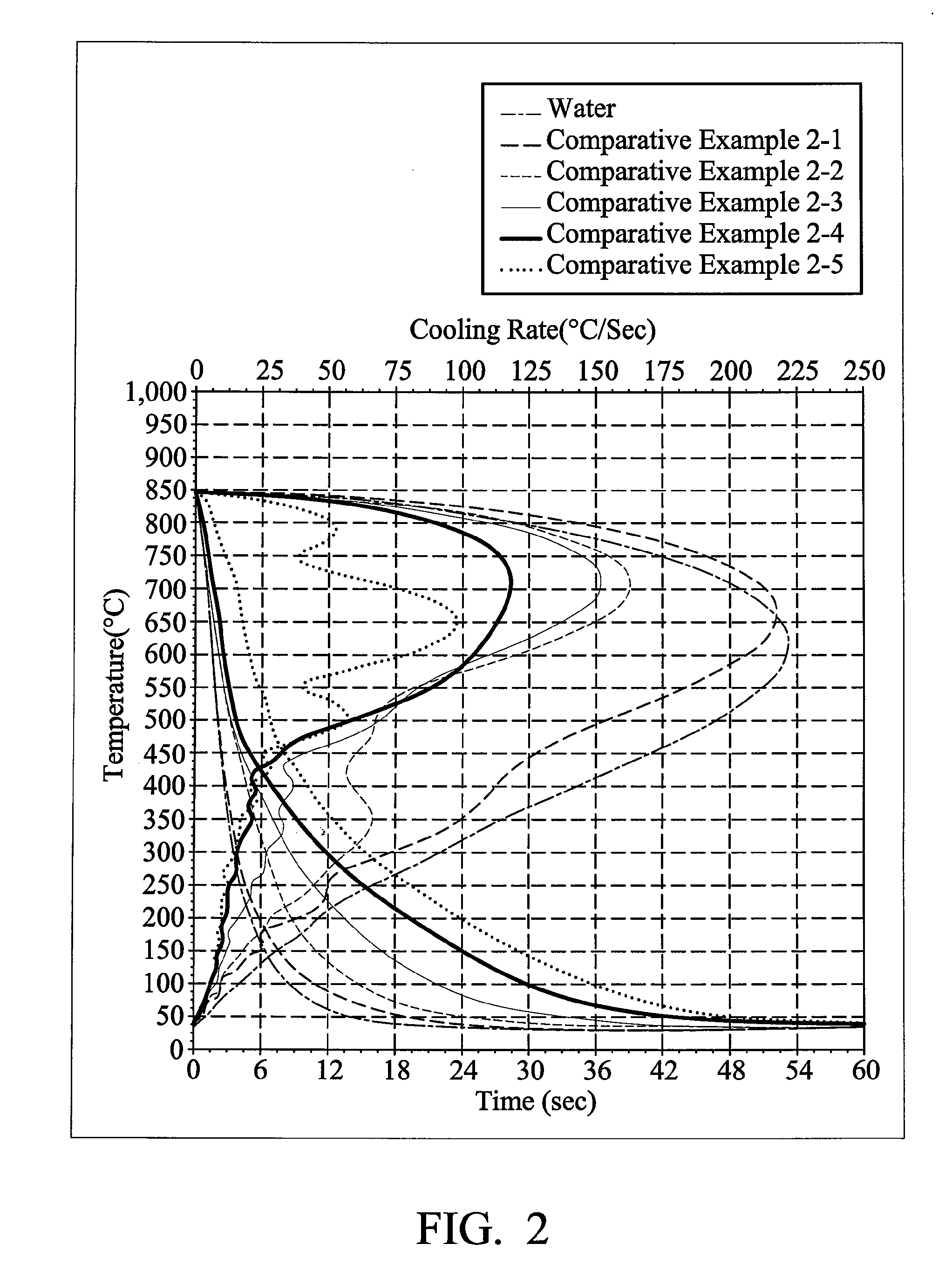Polymeric quenchant, manufacture thereof, and method for quenching steel
a polymer and quenching technology, applied in the field of quenching, can solve the problems of slow cooling rate and still does not meet the requirements of the steel industry
- Summary
- Abstract
- Description
- Claims
- Application Information
AI Technical Summary
Benefits of technology
Problems solved by technology
Method used
Image
Examples
working example 1
Effect of Inorganic Nanoparticle to Cooling Curve
[0036]The same procedure carried out in Comparative Example 1 was repeated except that the components of the quenchant was changed to 0.05 wt %, 0.1 wt %, 0.2 wt %, 0.5 wt %, 1.0 wt %, and 1.5 wt % of a PK 812 inorganic nanoparticle, respectively, and 15 wt % of an SQ1500 polymer. Referring to FIG. 3 and Table 3, maximum cooling rate and cooling rate at 300° C. decreased, dependant upon increasing concentrations of the PK 812 inorganic nanoparticle, but temperature at start of convection increased from 420° C. to more than 670° C. Additionally, temperature of maximum cooling rate increased, dependant upon the increased amount of PK 812 inorganic nanoparticle.
TABLE 3properties of Working Example 1 quenchantWorkingWorkingWorkingWaterExample 1-1Example 1-2Example 1-3SQ1500 Con. (wt %)0151515PK 812 Con. (wt %)000.050.1Maximum Cooling Rate (° C. / sec)221.43151.86157.24158.35Temp. Max. Cooling rate (° C.)611.42706.03716.61713.84Temp. at Star...
working example 2
Effect of Inorganic Nanoparticle and Polymer to Cooling Curve
[0037]The same procedure carried out in Comparative Example 1 was repeated except that the components of the quenchant was changed to 15 wt %, 20 wt %, and 25 wt % of an SQ1500 polymer and 0.5 wt % and 1.0 wt % of a PK812 inorganic nanoparticle, respectively. Referring to FIG. 4 and Table 4, maximum cooling rate and cooling rate at 300° C. decreased, dependant upon the increased amount of the PK812 inorganic nanoparticle, and temperature at start of convection increased, dependant on the increased amount of PK812 inorganic nanoparticle.
TABLE 4properties of Working Example 2 quenchantWorkingWorkingWorkingWaterExample 2-1Example 2-2Example 2-3SQ1500 (wt %)0151515PK 812 Con. (wt %)000.51Maximum Cooling Rate (° C. / sec)221.43151.86119.77102.75Temp. Max. Cooling rate (° C.)611.42706.03752.46778.4Temp. at Start of Boiling (° C.)846.13846.15846.75847.71Temp. at Start of Convection (° C.)41.5428.07634.14678.96Cooling Rate at 300° C...
working example 3
Effect of Inorganic Nanoparticle to Cooling Curve
[0039]50CrMo4 steel (10 mm diameter and 100 mm length) was treated with a quenchant of Example 3 and the cooling rate of the 50CrMo4 steel was detected by an IVF smart quench (IVF Industrial R&D Corporation). The quenchant of Example 3 comprised 2% of an FQ2000 (Petrofer) and 0 wt % to 1 wt % of a PK 812 inorganic nanoparticle (PAI KONG NANO Technology Co., LTD) as shown in Table 5. The viscosity of the quenchant increased when the concentration of the PK 812 inorganic nanoparticle increased. Referring to FIG. 5, cooling rate at 300° C. increased, dependant upon the increased amount of the PK812 inorganic nanoparticle (cooling curve of steel was gradually flatted).
TABLE 5properties of Working Example 3 quenchantWorkingWorkingWorkingWorkingWorkingWorkingExample 3-1Example 3-2Example 3-3Example 3-4Example 3-5Example 3-6FQ2000 Con.222222(wt %)PK812 Con.10.750.50.250.10(wt %)pH value101010101010viscosity (cps)221210.27.67—
PUM
| Property | Measurement | Unit |
|---|---|---|
| Temperature | aaaaa | aaaaa |
| Temperature | aaaaa | aaaaa |
| Fraction | aaaaa | aaaaa |
Abstract
Description
Claims
Application Information
 Login to View More
Login to View More - R&D
- Intellectual Property
- Life Sciences
- Materials
- Tech Scout
- Unparalleled Data Quality
- Higher Quality Content
- 60% Fewer Hallucinations
Browse by: Latest US Patents, China's latest patents, Technical Efficacy Thesaurus, Application Domain, Technology Topic, Popular Technical Reports.
© 2025 PatSnap. All rights reserved.Legal|Privacy policy|Modern Slavery Act Transparency Statement|Sitemap|About US| Contact US: help@patsnap.com



